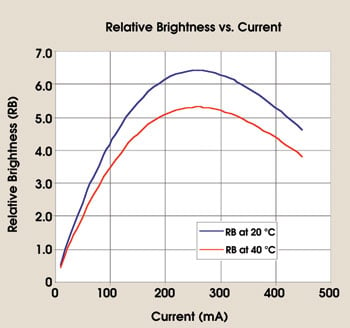Anne L. Fischer
Although LED performance has improved tremendously in the past 10 years, thermal management remains a major concern for manufacturers and end users alike. Running LEDs at elevated junction temperatures is detrimental to performance over both the short term (brightness and color shift) and long term (life expectancy). The ability to measure this parameter is therefore crucial to the thermal management design process. One researcher has developed a way to measure junction temperature rise directly for discrete components and also for LEDs mounted in an application.

After the time division multiplexing calculation is performed, two curves are plotted to show the relative brightness and current relationship.
Thermocouple and dominant-wavelength shift techniques have been used to measure LED temperature. However, because LEDs are encapsulated in transparent epoxy, the closest the thermocouple can measure is the cathode pin temperature. The dominant wavelength method works only for red or orange AlInGaP LEDs. For the InGaN blue LED and converted white LED, the junction temperature does not show any simple correlation to wavelength shift. According to Kelvin Shih, a professor of electrical engineering at Lawrence Technological University in Southfield, Mich., neither method measures the LED junction directly and accurately.
Thermal management
The time division multiplexing method that Shih developed measures the LED junction temperature rise relative to ambient temperature accurately, and it does so in real time. As the junction temperature of an LED is increased, the lumen output decreases, and the output wavelength shifts.
Therefore, accurate measurements of LED junction temperature rise will help in designing optimum thermal management. This optimization will increase lumen output, energy efficiency and life expectancy, and at the same time it will reduce the number of LEDs needed for the same lumen output.

Shih used two AlInGaP red LEDs from Agilent Technologies of Santa Clara, Calif., to demonstrate the method. After zeroing the test LED (when both reference LED and test LED are at ambient temperature), a calibration was performed with the test device in an environmental chamber so that the temperature rise could be read directly in degrees Celsius. The test was started with the drive current set to 120 mA. When the junction temperature stabilized at 42.7 °C, the current was 120 mA, and the forward drop was 1.95 V. The thermal resistance from junction to ambient can be calculated as:

Using this information, the junction temperature and relative brightness can be calculated at any current. After the calculation, two curves are plotted to show the relative brightness and current relationship.
These curves (see figure) show that maximum brightness occurs at 260 mA of current. When current is more than 260 mA, the brightness decreases. At 40 °C ambient at maximum brightness, the junction temperature is 146 °C, which exceeds the maximum allowed junction temperature of 120 °C. To prevent exceeding the 120 °C junction temperature, the current for this LED must be kept at 200 mA. At 40 °C ambient and 200 mA drive current, the relative brightness is only five times the 20 °C, 20 mA value. If the junction temperature is not taken into account by increasing the current from 20 to 200 mA, the brightness should increase 10 times.
Shih is working on a new time division multiplexing LED junction temperature tester that can drive the newer power LED to 1.5 A instead of the present 0.5 A. He also is working on a caloric power meter for LED applications.